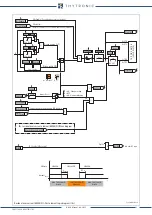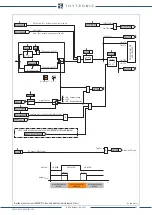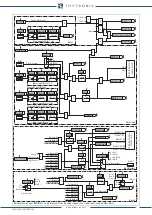
FUNCTION CHARACTERISTICS
63
NA30 - Manual - 04 - 2022
For every of the three thresholds the following block criteria are available:
Logical block (Block1)
If the
I>BLK1, I>>BLK1
and/or
I>>>BLK1
enabling parameters are set to
ON
and a binary in-
put is designed for logical block (Block1), the concerning element is blocked off whenever the given
input is active.
[1]
The enabling parameters are available inside the
Set\Profile A(or B)\Phase over-
current-50/51\
I> Element
(
I>> Element
,
I>>> Element) \Setpoints
menus, while the
Block1
function
must be assigned to the selected binary input inside the
Set\Inputs\Binary input IN1(2)
menus.
Selective block (Block2)
All along the protective elements the selective block may be set.
The logic selectivity function may be performed by means any combination of the following I/O:
• One committed pilot wire input (BLIN1).
• One or more binary inputs designed for input selective block.
• One committed pilot wire output (BLOUT1).
• One or more output relays designed for output selective block.
Only when the committed pilot wire are used the continuity check of the pilot wire link is active.
Use of committed pilot wire input BLIN1:
• The protection is blocked off according the selectivity block criteria when the input BLIN1 is active.
The information about phase or phase+earth block may be select programming the
ModeBLIN1
parameter inside the
Set \ Profile A(or B) \ Selective block-BLOCK2 \ Selective block IN
menus.
Use of binary inputs:
• If the
I>BLK2IN, I>>BLK2IN
and/or
I>>>BLK2IN
parameters are set to
ON
and a binary
input is designed for selective block (Block2), the protection is blocked off by phase elements
(Block2 Iph) or by any protection element (Block2 Iph/IE) according the selectivity block criteria.
[2]
The enable
I>BLK2IN, I>>BLK2IN
and/or
I>>>BLK2IN
parameters are available inside the
Set \ Profile A(or B) \ Phase overcurrent-50/51 \
I> Element
(
I>> Element
,
I>>> Element) \ Setpoints
menus, while the
Block2 Iph
and
Block2 Iph/IE
functions must be assigned to the selected
binary inputs inside the
Set \ Inputs \ Binary input IN1(x)
menus (IN1 or IN2 matching).
Use of committed pilot wire output BLOUT1:
• The information about phase or phase+earth block may be select programming the
ModeBLOUT1
parameter (
OFF - ON IPh - ON IPh/IE - ON IE
) inside
Set \Profile A(or B) \ Selective block-
BLOCK2 \ Selective block OUT
menus.
Use of output relay (K1...K6):
• If the
I>BLK2OUT, I>>BLK2OUT
and/or
I>>>BLK2OUT
enable parameters are set to
ON
and a output relay is designed for selective block (Block2), the protection issues a block output
by phase elements (BLK2OUT-Iph) or by any protection element (BLK2OUT-Iph/IE), whenever
the given element (Start I>, Start I>> e/o Start I>>>) becomes active. The enable
I>BLK2OUT,
I>>BLK2OUT
and/or
I>>>BLK2OUT
parameters (
ON
or
OFF
) are available inside the
Set
\ Profile A(or B) \ Phase overcurrent-50/51 \
I> Element
(
I>> Element
,
I>>> Element) \ Setpoints
menus, while the
BLK2OUT-Iph-K, BLK2OUT-Iph/IE-K
and/or
BLK2OUT-IE-K
output relays
and LEDs (
BLK2OUT-Iph-L, BLK2OUT-Iph/IE-L
e/o
BLK2OUT-IE-L
) must be select inside the
Set \ Profile A(or B) \ Selective block-BLOCK2 \ Selective block OUT
menu.
Internal selective block (Block4)
As well as to send or transmit a selective block toward other protective relays, each protective
element may be enabled for receive or transmit a selective block from/to other internal protective
elements.
[3]
The internal selective block of one or more element concerning the phase overcurrent function may
be enabled/disabled by means the
I>BLK4
,
I>>BLK4
, and/or
I>>>BLK4
parameters (virtual
input and output common to all protective thresholds); the following operating modes are available:
• IN - the element is enabled to receive the selective block from an internal input.
• OUT - the element is enabled to send the selective block to an internal output.
• OFF - the element is disabled to send/receive the internal selective block.
Transmission and reception for the same element is not allowed, so any stall situation due to wrong
setting is avoided.
The internal selective block can work together with an external selective block from other protective
relays (Block2).
Note 1 The exhaustive treatment of the logical block (Block 1) function may be found in the “Logic Block” paragraph inside
CONTROL AND MONITOR-
ING
section
Note 2 The exhaustive treatment of the selective block (Block 2) function may be found in the “Selective Block” paragraph inside
CONTROL AND
MONITORING
section
Nota 3 The exhaustive treatment of the internal selective block (Block 4) function may be found in the “Internal selective block” paragraph inside
CONTROL AND MONITORING
section.
















































